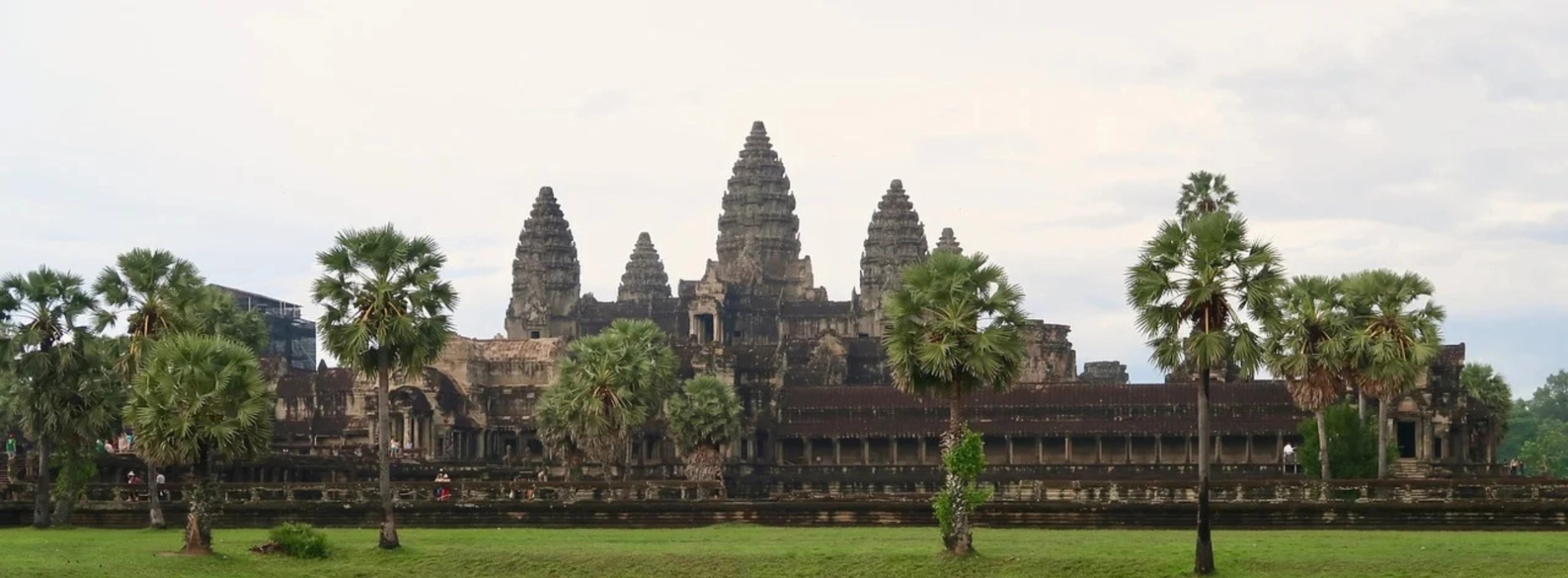
Did you know that besides Angkor Wat, there are over 1,000 temples scattered across the Angkor Archaeological Park? With such a huge number, exploring on foot is nearly impossible. Taking a tuk-tuk can be pricey and raise pollution concerns. That’s why the Angkor Wat cycling tour is the perfect solution, and Asia King Travel is here to explain why.
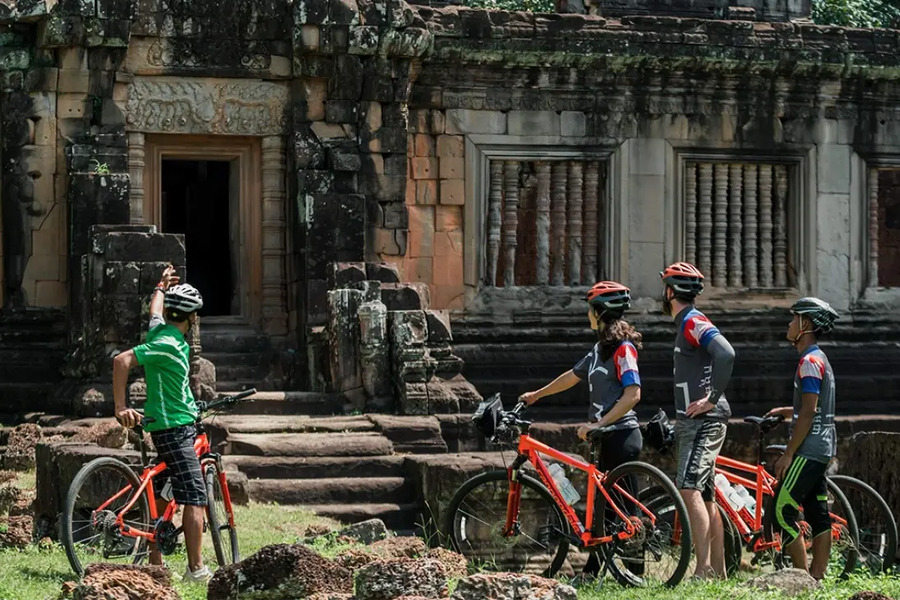
Angkor Wat cycling tour will bring you the most natural experience
Angkor was once a thriving city that stretched across a massive 400 square kilometers, and even today, you’ll find around 1,000 temples scattered throughout the area. As you can probably guess, it’s way too large to explore on foot. Most travelers hop on a tuk-tuk tour or hire a private driver, which is fine, but honestly, cycling is where it’s at. If you’ve ever dreamed of cycling Angkor Wat at sunrise, with mist rising through the temple spires, this is your chance.
Angkor Archaeological Park is surprisingly bike-friendly. Many of the main roads have dedicated cycling lanes, and local drivers are used to sharing the space with cyclists. Around the temples, shady forest paths wind through the trees, offering a peaceful (and cooler) escape from the Cambodian sun. The best part is that the terrain is almost completely flat, a total blessing when you’re pedaling through that tropical humidity!
The Small Circuit is ideal for a half-day or 1-day bike tour in Angkor Wat. Covering around 17 kilometers, this loop takes you past some of the most iconic temples in the park, all without the overwhelming distances of the Grand Circuit.
The ride typically starts at Angkor Wat, the crown jewel of the Khmer Empire and the largest religious monument in the world. From there, cycle north toward the majestic Angkor Thom, entering through the famous South Gate lined with stone-faced giants. Inside Angkor Thom, you'll find highlights like Bayon Temple, with its 200+ serene stone faces, and the Terrace of the Elephants, once used for royal ceremonies.
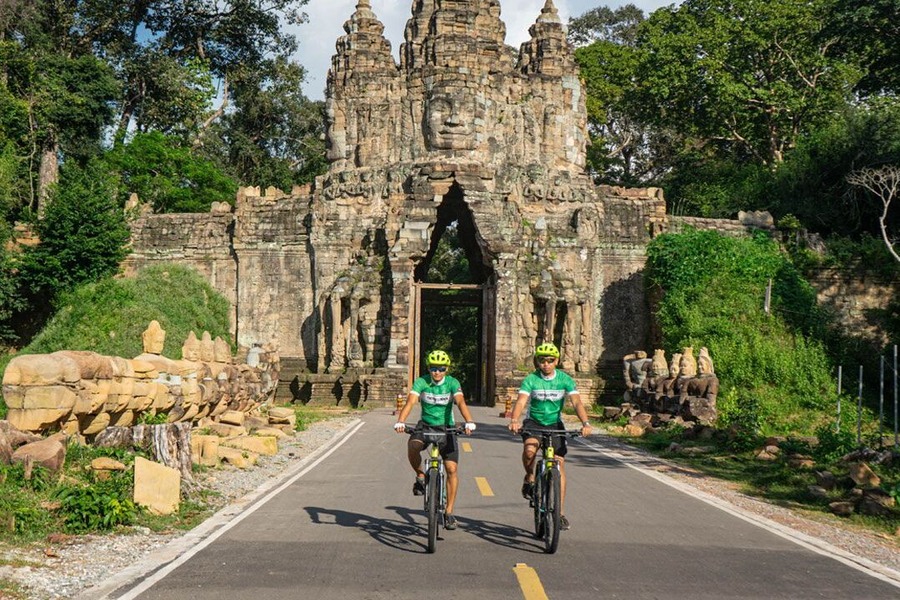
The small circuit takes you through the main temples of Angkor
Next, head east to Ta Prohm, the “Tomb Raider Temple” made famous by its tangled tree roots wrapping around crumbling stone walls. It's one of the most atmospheric spots in the entire complex. Don’t rush over it. After that, the loop brings you past smaller yet charming temples like Banteay Kdei and Srah Srang.
The Small Circuit is relatively flat, shaded in many parts, and offers a nice mix of grandeur and mystery, all within half a day of cycling. It’s a great introduction to Angkor if you're biking for the first time, or if you just want a manageable ride with maximum wow factor.
Stretching around 26 kilometers, this loop offers a chance to explore some of the lesser-visited, but no less magical, temples scattered through the northern and eastern parts of Angkor Archaeological Park.
The Grand Circuit usually picks up where the Small Circuit ends, beginning near Angkor Thom and heading northeast. Your first major stop is Preah Khan. Unlike more crowded spots, you’ll often find yourself wandering here in near solitude.
Continue onward to Neak Pean, a tiny island temple in the middle of a tranquil pond. The path then leads to Ta Som, a smaller temple with a photogenic tree swallowing the eastern gate, like a quieter, hidden cousin of Ta Prohm.
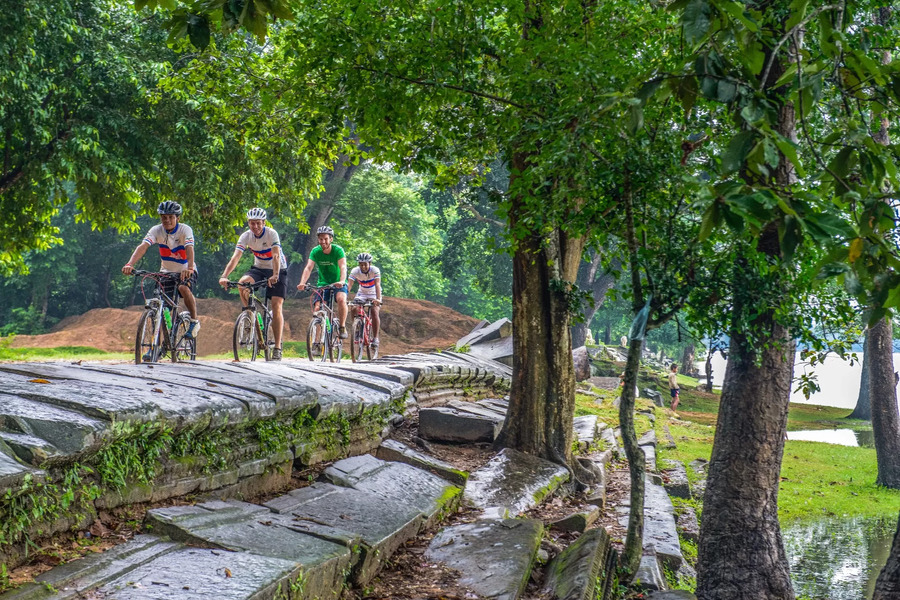
The grand circuit goes a bit farther, taking you to lesser-known temples
As you cycle further, you’ll reach East Mebon, which once stood on an artificial island in the now-dry East Baray reservoir. Its stone elephants guarding each corner are a highlight. Not far from there is Pre Rup, a pyramid-style temple that many travelers say offers one of the best sunset views in the park.
Though longer than the Small Circuit, the Grand Circuit is still quite doable for most cyclists, especially with early starts and plenty of water breaks. The roads are generally flat and well-shaded, with fewer crowds and a more peaceful, adventurous vibe. It’s the ideal route if you’re seeking a mix of majestic ruins and off-the-beaten-path moments.
The Small Circuit is shorter (about 17 kilometers) and includes the most famous and iconic temples: Angkor Wat, Bayon, Ta Prohm, and Angkor Thom. If it's your first time visiting the temples or you’re on a tight schedule, this route hits all the big names without being too exhausting. Plus, it fits perfectly into a customized Cambodia cycling tour itinerary.
On the other hand, the Grand Circuit is longer (around 26 kilometers) and goes further out into quieter areas of the park. You’ll see fewer crowds and explore more “hidden gem” temples. This route is ideal if you've already seen the major temples or simply want to escape the busier spots.
In terms of terrain, both circuits are relatively flat and bike-friendly. If you're short on time or want a more relaxed experience, the Small Circuit is perfect for cycling Angkor Wat without overwhelming yourself. The Grand Circuit, meanwhile, is ideal for those who want a full-day adventure on two wheels. By the way, you could even combine both over two days for a full Angkor experience by bike.
Thankfully, renting a bike in Siem Reap is super easy. You will find plenty of bike rental shops around the town, especially near the Old Market area and along Wat Bo Road. Standard city bikes usually cost around USD 5 - USD 10 per day.
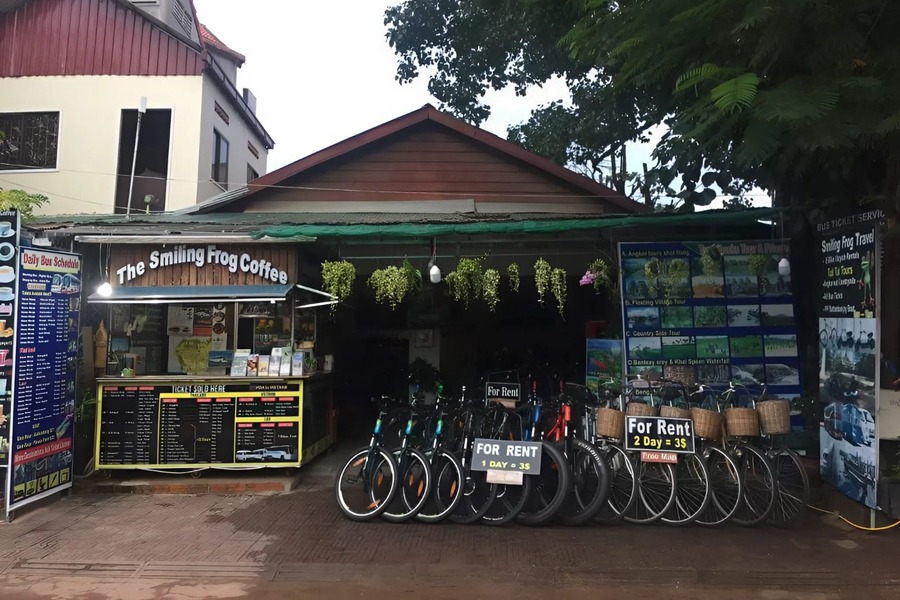
There are plenty of places to rent bicycles near Angkor Wat
If you’re planning to cover more ground or want something more durable, go for a mountain bike or hybrid bike, which typically costs USD 15 - USD 20 per day. Some rental shops also offer helmets, locks, and baskets for free or a small fee.
Suggested for you: Siem Reap Cycling Tour 7 Days: Explore Angkor Temples
Booking a guided bike tour in Angkor Wat means you don’t have to worry about directions or missing important temples. A bike guide will navigate and tell you about everything in Angkor while you are still confused about what to do. Prices usually range from USD 30 - USD 50 per person per day. These tours typically include: a quality bike and helmet, an experienced local guide, bottled water, and sometimes snacks or lunch, supported accessories.
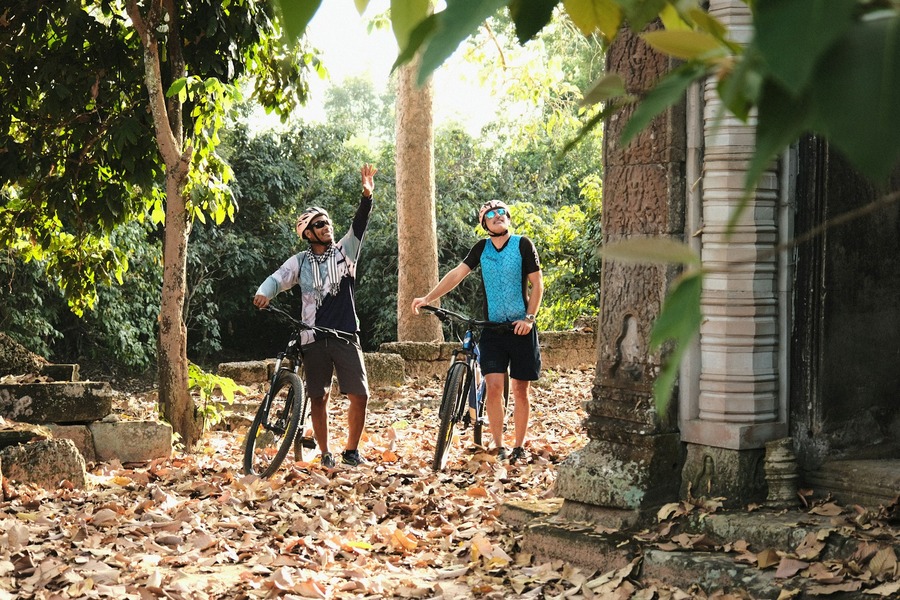
Having a local guide can be incredibly helpful for your cycling journey
One thing to note is that temple entry passes (Angkor Pass) are usually not included in the tour price, so be sure to purchase yours beforehand.
The best time to enjoy a cycling tour around Angkor is during the cool, dry season from November to March. December and January are especially popular months, so expect more visitors at the main temples. But the peaceful forest paths and less-traveled temples on the Grand Circuit still have lots of space to breathe.
If you're planning to catch the iconic sunrise over Angkor Wat (you definitely should), aim to arrive at the South Gate by 4:50 AM to claim a good viewing spot. The temple gates open at 5:00 AM sharp, so lock up your bike and make your way to the center edge of the reflecting pool. That’s where you’ll get the most picture-perfect view as the sun rises behind the temple’s spires.
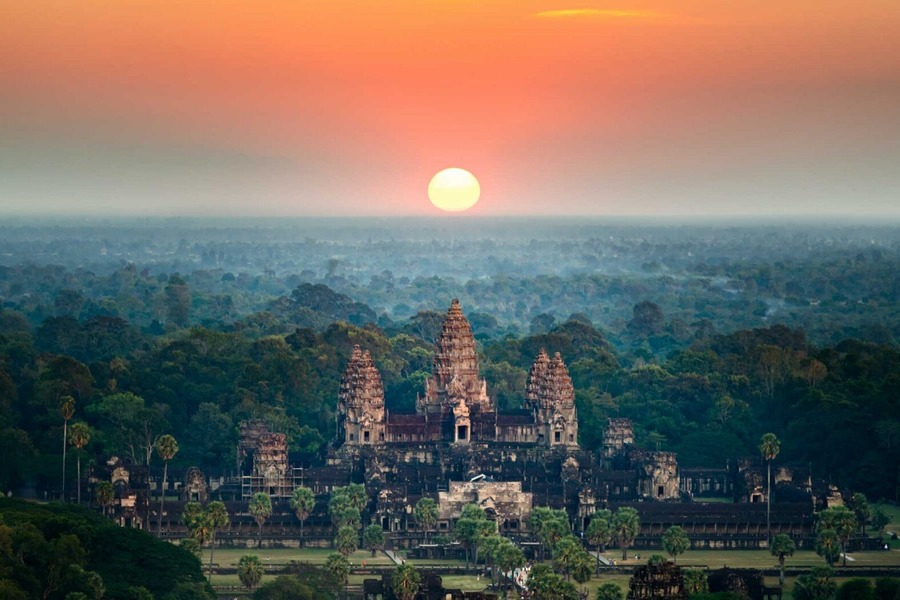
The sight everyone wants to witness when visiting Angkor Wat
Once you’ve soaked in the sunrise and explored a bit, hop back on your bike and ride about 20 minutes southeast to Banteay Kdei. Built in the late 12th century and now partly swallowed by the surrounding jungle, this lesser-visited temple offers a peaceful, almost spiritual contrast to the buzz of Angkor Wat.
The crumbling corridors and mossy stonework give it a dreamy, forgotten-world feel. You might even come across a Buddhist monk or nun, or hear the soft sounds of a traditional Buddhist band playing near a small shrine by the entrance.
After taking in the calm at Banteay Kdei, hop back on your bike and continue your journey to Ta Prohm. It’s just a 10-minute ride through the shaded forest trails.
Nicknamed the “Tomb Raider Temple”, Ta Prohm is Angkor’s second most visited site, so prepare to share the space with a good number of fellow explorers. This temple earned worldwide fame thanks to the Tomb Raider movie starring Angelina Jolie. The ruins are dramatically overgrown by massive silk-cotton and strangler fig trees, their roots twisting around ancient stone like something out of a fantasy novel.
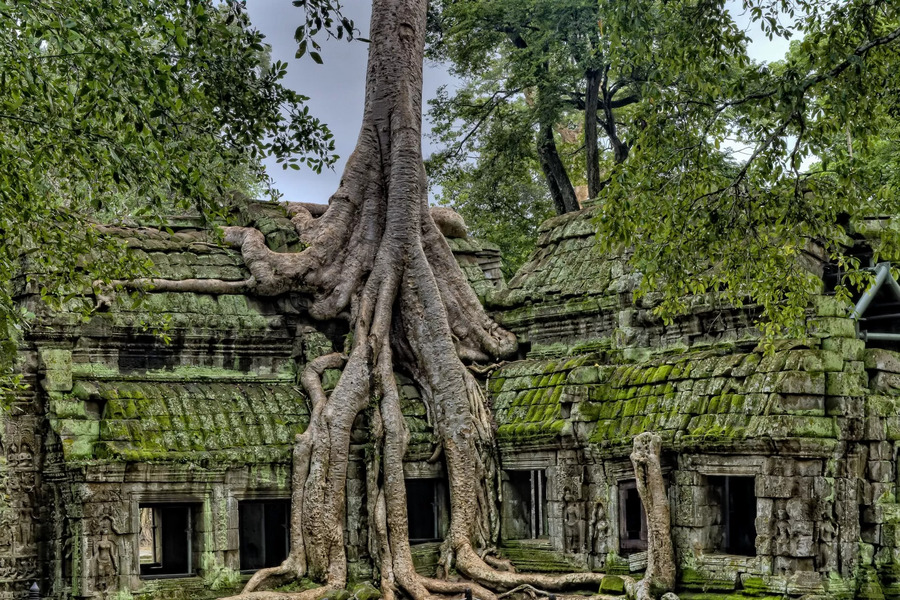
Even movies can’t capture the full grandeur of this breathtaking scene
Your next stop is Ta Keo, a lesser-known gem that many visitors skip, but is well worth a visit. Hop back on your bike and pedal for another 10 to 15 minutes to reach this massive, unfinished 11th-century temple. Surrounded by dirt paths and jungle, Ta Keo has a raw, almost mysterious feel to it.
When you’re ready to move on, continue cycling a few more minutes toward the Victory Gate, one of the grand eastern entrances to Angkor Thom, the legendary Great City of Angkor. Ride through the towering gate framed by giant stone faces, and you’ll soon come upon the Terrace of the Elephants.
Stretching 350 meters along the royal square, this stone platform was once used by Khmer kings for public ceremonies and as a viewing stand for parades and performances. The wooden superstructure that once stood atop it has long disappeared, but the intricately carved elephants and mythical creatures still make it easy to imagine the grandeur of ancient Angkorian court life.
A ride on Angkor Wat cycling tour will give you a kind of quiet magic that’s hard to find in a tour bus. By the end of the day, your legs might be sore and your shirt sweaty, but your heart will be full. Finally, let Asia King Travel help you create unforgettable memories. One adventure at a time.
Suggested for you: Angkor Complex Tours